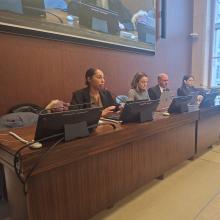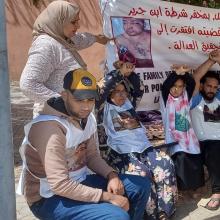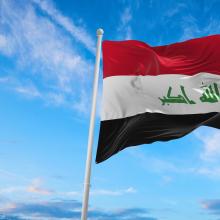October 01, 2020

October 1, 2020 marks the one-year anniversary of the beginning of the anti-government protests that erupted in multiple governorates across Iraq last year. The demonstrations over unemployment, corruption, and poor public services were met with excessive and unnecessary use of lethal force and live ammunition, leaving at least 487 people dead and many more injured. At the same time, the security forces and government-affiliated militias increasingly resorted to enforced disappearances against peaceful protestors.
Noting that such practice contributes to instil a climate of fear among demonstrators, MENA Rights Group submitted a communication to the UN Special Rapporteur on the rights to freedom of peaceful assembly and of association to call on the authorities to investigate the fate and whereabouts of six protesters who remain missing*.
All of these cases are currently pending before the UN Committee on Enforced Disappearances (CED). The authorities have so far failed to provide any information on the steps taken to search for the disappeared persons or to investigate their disappearance.
The case of Ali Jasib Hattab Al Heliji is illustrative of this practice that arose in the early days of the Iraqi protests as well as of the State’s failure to put an end to it. Ali is a human rights lawyer, who was representing several demonstrators arrested in connection with the anti-government demonstrations.
On October 8, 2019, he went to the southern city of Amarah to meet one of his clients. Shortly after arriving at the rendezvous point, he was arrested by members of the Ansar Allah Al Awfiya militia. Two days before his arrest, two armed men from the Popular Mobilisation Units (PMU) came to his home to warn him to stop speaking out on Facebook about the killing of protesters and to stop accusing certain factions of the PMU of being responsible for these killings.
When his relatives reported his abduction, local security forces told them that they were not aware of his arrest. Ali’s fate and whereabouts remain unknown until to date. His father is still looking for him: “The father and the mother and the children await those they are missing and continue living off of whatever remembered past still binds them to those they have lost”, he says in grief.
The cases documented by MENA Rights Group are only the tip of the iceberg. More Iraqis have disappeared since: according to the UN Assistance Mission for Iraq (UNAMI), 123 people have disappeared in the context of the protests between October 2019 and March 2020.
Although many demonstrators have been released after being secretly detained for a few days – if not weeks –, a number of them are still missing. As of August 2020, the whereabouts of 103 of them could be confirmed, while 20 remained missing or their status was unknown.
Militias affiliated with the PMU have reportedly played a critical role in the abduction of Iraqi demonstrators. The PMU, also known as Hashd Al Shaabi, were formed in 2014 to contain the offensive of the Islamic State of Iraq and the Levant (ISIL). In February 2016, they were formally incorporated as an “independent military formation” within Iraq’s security forces under the Prime Minister’s command.
“Iraq is the country with the highest number of enforced disappearances. The perpetration of the practice is ongoing, widespread and systematically implemented by the authorities and state-sponsored militias. Anyone voicing dissent risks being forcibly disappeared,” deplores the director of MENA Rights Group, Inès Osman.
According to the International Commission on Missing Persons estimates, the total number of missing persons in Iraq – from decades of conflict and human rights abuses – could range from 250’000 to one million.
Prime Minister Mustafa Al Kadhimi vowed to hold perpetrators of assaults on protesters accountable and to investigate cases of abduction and enforced disappearance. However, the authorities have repeatedly failed to address the issue. On September 20, 2020, Sajjad Al Iraqi, a prominent activist and protestor, was allegedly kidnapped by members of a militia affiliated with the PMU in Nasiriyah city, southern Iraq.
“The draft law on enforced disappearances, introduced before Iraq’s Council of Representatives in 2017, is still pending,” Inès Osman said. “We hope that the new Iraqi administration will finally address the issue and make the clarification and prevention of enforced disappearances a priority,” she adds.
Iraq ratified the International Convention for the Protection of All Persons from Enforced Disappearance (ICPPED) in 2010. The authorities have yet to fulfil their obligations under the Convention to investigate and clarify the fate and whereabouts of the missing persons, to bring those responsible to justice and to introduce a national legal framework in line with international law.
*The communication included the following cases:
Abdel-Messih Romeo Jean Sarkis, a daily worker from Baghdad, who participated in the anti-government demonstrations. He was abducted on the night of March 1, 2020 at Al Kuhlani square. His fate and whereabouts remain unknown until to date.
Osama Al Tamimi, a freelance photographer, who disappeared on January 2, 2020 near Al Tahrir square in Baghdad. He had documented the protests with his camera and was abducted when returning home. His fate and whereabouts remain unknown until to date.
Tawfiq Mohamad Hasan Atwan Al Tamimi, a journalist and editor, who disappeared on March 9, 2020 in the Ur neighbourhood of Baghdad. He had posted content on Facebook calling for the release of Mazen Latif, a publisher and writer disappeared in February 2020. Tawfiq Al Tamimi also voiced support for the Iraqi protests online.
Mahmoud Ali Khaz’al Alak Al Shuwaili who disappeared on December 2, 2019 at Tahrir square in Baghdad after leaving the broadcast of a football game at the square. Mahmoud had attended most of the protests. He was seen by a former detainee inside Baghdad airport prison in August 2020.
Ziyad Hadi Mohammad Al Janabi, a taxi-driver, who disappeared on November 22, 2019 near Al Tahrir square in Baghdad. He had driven protesters to the anti-government demonstrations. Ziyad Al Janabi has not been seen since.
Ali Jasib Hattab Al Heliji, a human rights lawyer, who was abducted in the Iraqi city of Amarah on October 8, 2019.
Although the families of the above-mentioned victims often did not receive any information concerning the perpetrators responsible for their enforced disappearance, state security forces and militias – most of which are affiliated with the PMU – are suspected to have carried out the enforced disappearances. Enquiries by the families about the whereabouts of their beloved ones at local police stations or the Ministry of Interior did not yield any results.
Please note that this press release has been modified on October 2, 2020.






